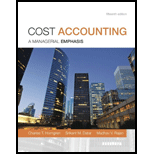
1.a.
To compute: Allocation of joint cost as per sales value at split off method:
Given information:
Joint cost is $62,000
Selling price of chocolate powder liquor base is $20.
Selling price of milk chocolate liquor base is $60.
1.b.
To compute: Allocation of joint cost as per physical measure method:
1.c.
To compute: Allocation of joint cost as per NRV method:
Given information:
Joint cost is $62,000
Total production of chocolate powder is 9,100 pounds.
Total production of milk chocolate is 14,980 pounds.
Selling price per pound of chocolate powder is $9 per pound.
Selling price per pound of milk chocolate is $10 per pound.
Separable cost is
1.d.
To compute: Allocation of joint cost as per constant gross margin percentage NRV method:
Given information:
Joint cost is $62,000.
Sales value of total production as computed is $968,800.
Separable cost is
2.a.
To compute: Gross margin percentage under sales value at split-off point.
2.b.
To compute: Gross margin percentage under physical measure method.
2.c.
To compute: Gross margin percentage under NRV method.
2.d.
To compute: Gross margin percentage under constant gross margin percentage NRV method.
3.
Effect on operating income due to change in decision to further process both intermediate products.
Given information:
Sales value after process is computed to be $81,900.
Sales value at split-off is computed as $14,000.
Separable cost is $50,100.
Want to see the full answer?
Check out a sample textbook solution
Chapter 16 Solutions
Cost Accounting: A Managerial Emphasis, 15th Edition
- Hello tutor please given General accounting question answer do fast and properly explain all answerarrow_forwardPlease provide the solution to this general accounting question with accurate financial calculations.arrow_forwardI need help solving this general accounting question with the proper methodology.arrow_forward

 AccountingAccountingISBN:9781337272094Author:WARREN, Carl S., Reeve, James M., Duchac, Jonathan E.Publisher:Cengage Learning,
AccountingAccountingISBN:9781337272094Author:WARREN, Carl S., Reeve, James M., Duchac, Jonathan E.Publisher:Cengage Learning, Accounting Information SystemsAccountingISBN:9781337619202Author:Hall, James A.Publisher:Cengage Learning,
Accounting Information SystemsAccountingISBN:9781337619202Author:Hall, James A.Publisher:Cengage Learning, Horngren's Cost Accounting: A Managerial Emphasis...AccountingISBN:9780134475585Author:Srikant M. Datar, Madhav V. RajanPublisher:PEARSON
Horngren's Cost Accounting: A Managerial Emphasis...AccountingISBN:9780134475585Author:Srikant M. Datar, Madhav V. RajanPublisher:PEARSON Intermediate AccountingAccountingISBN:9781259722660Author:J. David Spiceland, Mark W. Nelson, Wayne M ThomasPublisher:McGraw-Hill Education
Intermediate AccountingAccountingISBN:9781259722660Author:J. David Spiceland, Mark W. Nelson, Wayne M ThomasPublisher:McGraw-Hill Education Financial and Managerial AccountingAccountingISBN:9781259726705Author:John J Wild, Ken W. Shaw, Barbara Chiappetta Fundamental Accounting PrinciplesPublisher:McGraw-Hill Education
Financial and Managerial AccountingAccountingISBN:9781259726705Author:John J Wild, Ken W. Shaw, Barbara Chiappetta Fundamental Accounting PrinciplesPublisher:McGraw-Hill Education





